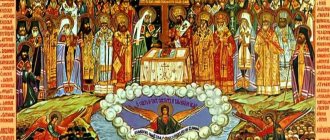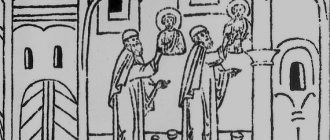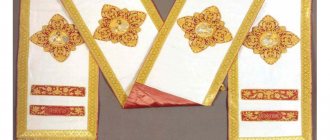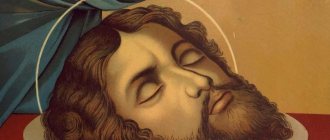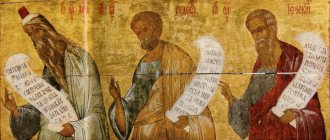Recently, embroidery has become a very popular activity. Needlewomen from all countries enthusiastically embroider with cross stitch, satin stitch, and beads. The result of creative and painstaking work are wonderful landscapes, still lifes, portraits and other interesting subjects. And many believing needlewomen embroider icons.
Embroidery of icons is a special topic in needlework, since until now there is no clear opinion on this matter either among needlewomen or among clergy. There are just a lot of questions. Isn't it a sin to embroider icons? Do you need to follow certain rules when embroidering icons? What are the subtleties and features of this activity?
To begin with, I would like to understand what an ICON is . After all, the Orthodox icon is an integral and important part of the spiritual life of a Christian. She meets a person after his birth, stays with him throughout his life's journey and escorts him to another world.
The icon plays the role of a mystical mediator between the earthly world and the heavenly world. The main thesis of icon veneration: “The honor given to the image goes to the Archetype.”
An icon is an Orthodox liturgical image. Any icon is deeply symbolic. In order to come closer to understanding icons, one must see them through the eyes of a believer, for whom God is an undoubted reality, despite all its incomprehensibility and inaccessibility.
Therefore, a logical question arises among needlewomen: is it a sin to embroider icons ?
Opinion of Archpriest Alexander Saltykov, rector of the Church of the Resurrection of Christ in Kadashi, dean of the Faculty of Church Arts of PSTGU:
“I don’t see anything wrong with a needlewoman embroidering an icon image, if there is no bad intent in it. But I think that at the same time she should receive the blessing of a priest for her work. Perhaps this embroidery will be the first step towards the craftswoman deciding to learn more about church art, about the icon and the image depicted on it. Maybe he will want – and this is the main thing – to delve deeper into spiritual life.”
And there are quite a lot of such opinions.
There are much fewer statements against icon embroidery, but nevertheless they exist. Opinion of Priest Gregory from Holy Trinity Parish in Volgograd:
“Bead embroidery is not a traditional technique for making icons and has nothing to do with Orthodox iconography and icon veneration. Doing needlework is useful for everyone, you can embroider a lot of beautiful things, but it is not prudent for the average person to cross the boundaries of the sacred and try to make a sacred image, the preparation of which is offered by worldly manufacturers...”
He advised the woman who asked him for a blessing to embroider icons to stop this activity, burn the workpiece and not do such things anymore.
But still, most clergy do not see anything negative in embroidering icons. The main thing is that the work is done in the appropriate mood and the craftswoman understands that in front of her is not just a picture, but a symbol that needs to be treated with special respect, awe and veneration.
Previously, there was no need to consecrate icons
Our ancestors did not think about how to consecrate an icon. In the church or at the monastery there were people who were icon painters. These are not just artists, but those whose calling is to paint Christian images.
Creating an icon is not only a craft and a creative process, but also a spiritual act. Not everyone was allowed to see him. What was needed was a pious man who not only approached his work with reverence, but also followed the Law of God.
The priest sprinkles the icon with holy water. This is an important moment when consecrating the image. This is how the grace of the Holy Spirit is transmitted to him. Photo: spirovo.ortox.ru
All instruments were often made nearby, using holy water. And so it turned out that in the end, not just an image was born - but an image sanctified due to what it was made of and by whom.
Was it necessary to consecrate such icons? Not at all.
Why is it necessary to consecrate icons now?
It must be remembered that any icon is the spiritual image of a person who is considered holy in the Christian religion. The most holy image was created for prayer, that is, for the believer’s communication with the Savior. At the moment of prayer, the Holy Spirit descends on the iconographic image. Before the holy face, a believer repents for his sins and asks God for mercy.
A holy image purchased in a church shop, as a rule, complies with all the canonical rules for writing iconographic religious objects and is already consecrated. If the image with the Savior, the Mother of God or saints was purchased in an antique or ordinary store, on the market, or made independently, then it is advisable to take it to the church for examination and consecrate it.
The fact is that not all paintings depicting Jesus, the Immaculate Virgin Mary or martyrs are icons. Sometimes such drawings are classified as works of art on religious themes. When painting icons, they adhere to a number of rules that correspond to the traditions of icon painting, the founders of which were such icon painters as Andrei Rublev, Daniil Cherny and others. In ancient times, the artist painted a holy image, and the bishop wrote an inscription on it. The clergyman wrote on the icon the name of the saint whom the icon painter depicted. The bishop’s inscription confirmed that the image was created canonically correctly and one can pray in front of it.
Nowadays, it is allowed to consecrate icons purchased in a store or created with one’s own hands in a church. Priests participate in the consecration ceremony. Before the most holy image, special prayers are read, it is sprinkled with holy water and smoke from incense is burned. If a personal or family icon is consecrated, then its owner must be present in the ceremony in the temple.
Any holy image is consecrated only once. According to church regulations, only ancient or found holy iconographic images require re-consecration. The second time they consecrate an icon that has been desecrated or thrown into the trash.
Previously, icons were single-piece items, but now, due to commerce, anyone can make them
But over time, Orthodoxy in Rus' acquired colossal proportions. The number of believers increased, and the religion itself began to transform. If previously the church served as a place where people communicated with God and with each other, then later they began to pay more attention to paraphernalia.
It's good? Badly? Honestly, it's always better when a person gets to the point. We must live according to religion, and not limit ourselves to the cult of objects.
XVII
century, when the demand for icons increased in the homes of Russian believers
No, there is nothing wrong with wanting to have an image of a saint with you. On the contrary, it is a way to pray with concentration, plus there is always an example of spirituality before your eyes.
But the whole trouble is when an icon turns into an object of some kind of cult, when a person imagines that possessing it in some way already makes him a pious Christian.
By the 17th century, the demand for icons increased. The masters remained, but it is clear that they were far from able to satisfy the demand for icons among believers.
The emphasis on mass appeal made icon painting a craft.
They were no longer drawn by pious artists, but by people who simply made a living from it.
Then factory icons appeared altogether. So it is not surprising that believers want to return to tradition and purchase not just an image, but a consecrated icon for their home.
What rules must be followed when embroidering icons?
Rule #1. Blessing of the Priest
Priest Alexy's opinion:
“It’s a wonderful thing – a gift from God – to be involved in the creation of icons. As a matter that is intended to be soul-saving and pleasing to God, it requires the blessing of the clergy.”
It is necessary to show the clergyman a diagram or booklet from the embroidery kit so that he approves of your choice and gives a blessing for sewing the icon (“blessing is Divine help, God’s approval, in church usage it means the permission of the clergy”).
The fact is that at present there are manufacturing companies that, pursuing exclusively commercial goals, produce patterns and kits for embroidering icons that do not comply with Orthodox canons. It is, of course, advisable to undergo the great sacrament of confession and communion. Because you are about to begin creating a liturgical image. And this must be done with a pure soul and a kind heart.
Rule #2. Prayer before starting work on embroidery
When starting to embroider an icon, you need to read a prayer. There are special prayers for icon painters and craftsmen, but you can read any prayer that you know or turn to the saint whose image will be embodied in embroidery.
Opinion of Archpriest Georgy Schmid:
“...embroidery of an image should indeed be accompanied by prayer. Which? I think addressed to the One whose image you are working on.”
Rule #3. The pious life of a needlewoman
While embroidering Orthodox icons, one must observe fasting, limit idle entertainment, exclude alcohol, fatty foods, and animal products from the diet, and give up smoking. It is also advisable for the embroiderer to read canons, akathists, and other prayers. Reading prayers allows you to fully concentrate on creating an icon, understand your aspirations and torments, change your life for the better, and find peace of mind.
Opinion of priest Vyacheslav Bodan:
“...embroidery or painting an icon is not a hobby, not handicraft or anything like that. For those people for whom this was a matter of life, the creation of an icon was always inextricably linked with fasting and prayer, with a special mood of the soul, a rhythm and structure of life that was different from ordinary days.”
In the process of embroidering an icon, the craftswoman receives peace, is filled with piety, and is elevated spiritually. All vain thoughts and problems go away, only the soul remains.
There are many examples when, after sewing an Orthodox icon, the master was cured of a long and serious illness, and got rid of a series of troubles that had previously visited him.
Rule #4
When embroidering an icon, you need to drive away bad and sinful thoughts, you need to think only about the good, the good. You cannot get to work during a quarrel, family troubles, or in a state of mental anger, resentment, or envy. Girls and women on critical days are not supposed to touch the embroidery of icons.
Many people are interested in the question: is it possible to embroider faces and hands?
The answer from the clergy is unequivocal - no. The fact is that their image is strictly controlled by the canons. To paint them with paints you need permission from fairly high church officials. Therefore, many priests are against completely stitching icons with a cross and are more relaxed about ready-made kits for embroidering icons with beads. As a rule, such sets are designed taking into account all iconographic canons. Faces, hands and details that require special care are initially applied to the fabric with paint.
Rule #5
The finished work must be framed in an icon case (an icon case is a frame or ark (box) with glass in which the icon is placed). And then consecrated in the temple .
An icon embroidered with your own hands has a huge energy charge, because when creating it, the craftswoman puts a piece of her soul, good intentions, love and humility.
The image for consecration must comply with the canons
The question of the consecration of icons was first raised in the Western Church. There is nothing to be surprised here, because such processes have always occurred more dynamically there. And Western progress has always been ahead of what was happening in Rus'.
However, these trends have reached us too.
In addition, the situation was complicated by the fact that many people themselves began to paint icons at home. Sometimes these were images that deviated greatly from the canonical ones.
Amateur icon painters often create non-canonical images; they cannot be consecrated.
What is a canon in icon painting? This is strict symbolism, the inner essence of the image. If you step back from it, we are no longer faced with an icon, but with a picture. It is noteworthy that in the Russian Orthodox Church they are especially attentive to the canon. This is a legacy of the Byzantine approach.
But the Catholic world is a little more free with images of saints. But there they venerate icons a little differently. We value them more.
Consecration of icons
Healthy? Share the link!
The consecration of icons is a special rite of blessing of symbolic images that developed in historical Christian churches. It is held in churches and serves to endow the image with the grace of the Holy Spirit.
Consecration of the icon of the Mother of God
Image from the website of methodological support for primary theological education “Sunday School”
Why are icons consecrated?
Of course, there is nothing wrong with praying in front of an unconsecrated image. According to Saint John of Kronstadt, the images of the Cross of the Lord, the Savior, the Mother of God, angels and saints are holy in themselves in view of human intention in their production and use. On the other hand, the consecration of an icon by the Church recognizes the canonicity of the depicted image, ritual purification of the work of human hands is carried out and its dedication to the Lord.
We should also not forget that the blessed water that is sprinkled on the icon during consecration is one of the gifts of God that we can use with gratitude to the Lord, and therefore it is not very useful to neglect it. For this reason, by the way, not only icons are consecrated, but also housing, food and other things: thereby all aspects of a person’s life are introduced to grace.
In what cases should icons be consecrated?
All icons that were purchased outside church or monastery stores should be blessed. Found, inherited, donated - all of them require consecration, since it is not always clear whether they were consecrated earlier or not.
Icons that have undergone restoration or processing, as well as those that have been desecrated, must be consecrated, even if they have already been consecrated. And of course, icons painted by yourself or your friends are subject to the ritual.
The order of consecration of icons
In a number of sources you can read that to consecrate an icon it is not at all necessary to take it to the temple. It will be sufficient to repeat the prayer three times over the image: “By the grace of the Most Holy Spirit and the sprinkling of this holy water, this image is sanctified and blessed: in the name of the Father, and the Son, and the Holy Spirit, Amen,” and the ritual can be considered complete. Sometimes even priests advise this, although most of them still disapprove of this practice and do not consider such icons to be sanctified.
In the modern practice of the Russian Orthodox Church, only icons over which a special rite was performed with the reading of certain prayers and three times sprinkling with holy water are recognized as consecrated. Today there are five such rites:
for the consecration of various icons offered together;
for the consecration of icons of Jesus Christ and the Lord's holidays;
for the consecration of icons of the Mother of God and Mother of God feasts;
for the consecration of icons of the Holy Trinity and holidays associated with it: Epiphany (Baptism), the Descent of the Holy Spirit, the Transfiguration of the Lord;
for the consecration of icons of a saint, several saints or their cathedrals.
The procedure for the consecration of icons can take place at any time of the day, but more often it is performed during the water blessing prayer or immediately after it, i.e. before noon. As for choosing the day of the week, icons can be brought to large churches every day: they are open every day. Small churches, as a rule, open their doors only on weekends and holidays: it is worth focusing on this mode of operation.
If it so happened that you brought the icon to the temple after the completion of the water blessing prayer, then it is worth checking with the headman or the seller of the church shop what to do in this situation. They will either hand over the brought icons to the priest for consecration, or offer to order a water-blessing prayer service.
The rite of consecration does not last long: only 10-15 minutes. But its importance is extremely great, because only after its completion the icon is recognized by the canons of the church.
History of the consecration of icons
People began to consecrate symbolic objects a very long time ago; even from the Old Testament we know about the consecration of the Tabernacle of the Covenant and the Temple of Solomon. Icons began to be consecrated much later: it was believed that compliance with the iconographic canon and the inscription on the icon of the name of the person depicted was enough to recognize the image as holy.
It is not known when and where the tradition of consecrating icons arose, but most likely it happened at the beginning of the 17th century somewhere in the West and was associated with the penetration of borrowings from secular works of art into icon painting. The emerging rite of consecration of icons served as a testimony to the Church about the authenticity of the icon, that the one depicted is the one who is inscribed.
After the schism that occurred in the 1650s - 1660s, icons began to be consecrated in Rus'. The rite was first recorded in the Trebnik of Peter Mohyla dated 1646. It is a revised translation of the rite for the consecration of icons from the Latin, Catholic liturgical collection “Rituale Romanum” of 1614.
The site needs your help!
Every day more and more people come to the site molitvoslov.today. This is what it was created for: to ultimately become the most popular and complete collection of prayers, akathists, canons and images of icons in RuNet. But to develop the resource, funds are needed: annual domain renewal, payment for hosting and services for article authors. I don’t want to cover the site with advertising like a Christmas tree. Therefore, a small request to everyone who scrolled the page to this place and who liked molitvoslov.today: I will be grateful for any financial assistance for its development. Peace to you!
An icon should also be consecrated if the image is desecrated or if its origin is unclear
But priests recommend lighting not only homemade and industrial icons; there are different circumstances:
- the icon was desecrated;
- the icon was restored;
- the icon was given as a gift, and we have no idea whether it was consecrated before;
- found the icon.
In each of these cases, we are dealing, as it were, with a new icon, into which the grace of the Holy Spirit must enter through the rite.
Antique icon of the Kazan Mother of God. It is usually impossible to find out whether such an icon was consecrated. Priests recommend consecrating them
To consecrate an icon, you need to contact a church worker or priest
Careful attitude towards the canon contributes to the fact that not every image of a saint can be consecrated. The Holy Spirit, as is commonly believed, will wish to enter only those images that are written according to all established rules.
The decision on whether an icon can be consecrated in a church is made by the priest. Anyone wishing to use this service should adhere to the following procedure:
- In church, contact the person who takes orders for services. Usually this person works at the entrance. We agree with him about when it will be convenient to communicate with the priest.
- If you have the opportunity to meet the priest in person, then the first point can be neglected.
- Then you agree on everything individually. There are no rules about what and how to do.
- As for payment, the church should not set tariffs for its services. Remuneration is a voluntary action, and its size is determined by the person himself. Unfortunately, there are other precedents. But this is already a question about the integrity of individual clergy.
For consecration, the priest reads a prayer and sprinkles the icon with holy water
Icons are blessed with holy water - not dipped, of course, but sprinkled. They also burn incense. At the same time, the priest reads a prayer.
Which one? It greatly depends on what kind of holy image is in front of him. Depending on the circumstances, a variety of ranks may be chosen. This includes the rite of consecration of various icons.
Regardless of the chosen prayer, the icon will be illuminated.
Some icons are not consecrated because of their content. For example, “Blessed Matrona blesses Joseph Stalin,” once exhibited in the Church of the Holy Equal-to-the-Apostles Princess Olga in Strelna, demonstrates a plot that is not acceptable for Christians. After a barrage of criticism on this image, it is unlikely that at least one priest will undertake to consecrate an icon on the same topic. Photo: cs.pikabu.ru
Principles of conducting a church ceremony
In ancient times, icons were painted only in monasteries, and in order to create a holy image, the icon painter had to fulfill a number of requirements.
Before painting the icon, it was necessary to fast, then confess and receive a blessing from the holy father to create the face of the saint. For this reason, the icons did not have to be consecrated, because they received the blessing of the church even before being painted.
In the modern world, many people try to write, embroider or create icons from different materials, but do not comply with church requirements.
Often such masterpieces are created even by those who do not believe in God, and sometimes it turns out that the purchased icon depicts a completely unholy face. If you bought an icon, before displaying it in your home, do the following:
- contact the priest with a request to determine the authenticity of the face depicted on the icon;
- ask the holy father to explain the meaning of the icon;
- ask for permission to consecrate the icon;
- order a special mass;
- only after the Mass can the icon be taken home and prayed to.
Today there are many religious denominations, each believes in God in its own way, but the main thing in our faith is the desire to bring good to people and spiritual purification. Buy icons and let them bring grace to your hearts and harmony to your families.
Icons purchased at the church have already been consecrated
Icons that are sold at the church do not need to be illuminated. It is understood that any church goods have already been blessed in advance before they are put up for sale.
If some church, in addition to the total cost, offers the “service” of consecration for an additional fee, then it makes sense to file a complaint with the diocese, because this is already speculation that discredits the image of the Russian Orthodox Church.
Where should icons be located in an apartment?
Only a priest can consecrate an icon independently.
The Internet is full of instructions on how to consecrate an icon at home. “Prepare holy water,” “take the cross,” “read a prayer.”
For the Russian Orthodox Church this is nonsense. Only the official representative of the Church of Christ, a priest, can consecrate icons. He has spiritual authority to do this.
A layman should be interested in how to consecrate an icon in a church or at home with the help of a priest.
Everything else is a practice alien to Orthodox Christianity.
Self-embroidered icon in a frame Photo: tonus-stroy.net.ru
Such embroidery kits are very popular among believers. But the chance that the finished product will be blessed by a priest is not great. They put their soul into a real icon, and such images often require only perseverance and nothing more.
Even if the icon is not consecrated, it deserves respect
And if the icon is not consecrated, what is it - a trifle? Of course not. Although the Church points out the importance of consecration, even without it the icon remains an image of grace, which for believers is an object of veneration.
In the history of the Russian Orthodox Church, there are cases when unconsecrated icons even streamed myrrh. So what matters is not what rituals we went through to create the image, but how we relate to it.
But at the same time, we should not forget that we do not honor the icon, but the holy man who is depicted on it. And we pray not to him, but to God, we simply ask the saint to join our prayer.
An icon made of beads or embroidered can also be consecrated in a church, if the image is canonical and made with soul
How to consecrate an icon made of beads? In the church. How else? It doesn’t matter what tool or what the image was created on. It is important how much soul there is in it and how it corresponds to church canons. But the important question is not “is it possible to consecrate an icon made of beads?”, but “is it necessary?”
In fact, a person has a passion for handicrafts. This is wonderful. He made a product with a religious theme. Also good. But why is sanctification necessary?
A handmade icon does not have to be consecrated; it can simply serve as decoration.
An icon made of beads may well become an interior object that will remind you of the lifestyle of a pious Christian. Why not?
The same applies to the question of how to consecrate an embroidered icon in a church. A holy image from any material can be consecrated. But not every image is suitable for this. Beautiful - yes, does it correspond to the canons - the question is.
Archpriest Alexander (Saltykov) comments on this situation as follows:
“To understand which images can be consecrated as icons, and which cannot, a priest needs to study. We must learn Orthodox dogma and Orthodox piety.
Then it will be clear to him that, for example, interpretations of the Holy Family, depicting the embrace of righteous Joseph and the Virgin Mary, are not only unacceptable, but also have a blasphemous element. We must study, then the boundaries of what is permissible will be clear.
In general, creativity is a good thing, but everything should have its place and its space. If a person presenting a picture as an icon is offended, then he needs to be taught the Orthodox faith. It is necessary to explain, using the same example, that Joseph is not the husband of the Virgin Mary, he is not her secular admirer, this is blasphemous.
If they are upset, it means we are not explaining to them well, we are not praying for them well. The short answer is that, of course, it is possible to consecrate homemade icons, including those embroidered and made of beads, but here the main criterion for the priest is piety, canons and church culture. To understand all this you need to study, study and study again.”
Alexander Saltykov
archpriest
So you should be prepared for the fact that the priest will refuse to consecrate this or that image. This is not a sentence. We have enough icons for prayers around us. And the value of the product does not depend in any way on consecration.
Archpriest Vladimir (Golovin) says in the video that the question of whether to consecrate an embroidered icon or not must be decided on an individual basis.
A person must make an icon with his soul. If this is visible, then the image should be consecrated, otherwise there will only be a picture:
Is it possible to embroider icons yourself? (Protege Vladimir Golovin, Bolgar)
By leaving a comment, you accept the user agreement
An icon embroidered with beads is also consecrated in the church.
Nowadays, the most holy images are created in different styles, including embroidery. Only those icons that are created in compliance with the iconographic style and meet strict canonical requirements are allowed for consecration. Before consecrating the image, the clergyman will check it. All priests are well versed in such matters. In theological educational institutions there are special disciplines for the study of images (iconology, iconology, theology of the icon).
If the master embroidered the icon with beads and in the process of work adhered to all the canonical rules for the attributes of the cult, then it can be allowed to be consecrated. The believer will be given a date on which the church service will take place. Usually several iconographic images are consecrated in a church at once.
